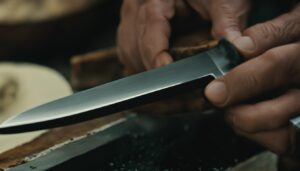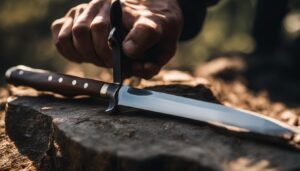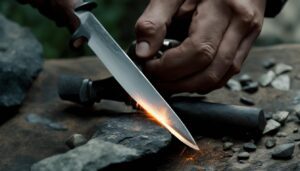Hunting knives are essential tools for hunters, but over time, they can become dull and lose their sharpness. Sharpening a hunting knife using a wet stone is a crucial skill for any outdoorsman. In this ultimate guide, I will provide detailed information on the techniques and tools you need to sharpen your hunting knife effectively. From understanding the different types of hunting knives to choosing the right sharpening tool, you will learn everything you need to know to keep your knife in optimal condition.
Key Takeaways:
- Regularly sharpening your hunting knife is essential for maintaining its performance.
- Understanding the type of knife you have is crucial for choosing the right sharpening technique.
- There are different types of sharpening tools available, such as sharpening stones and honing rods.
- Before sharpening, clean the blade, check for damage, and determine the correct sharpening angle.
- When sharpening with a wet stone, maintain a consistent angle and remove burrs for a sharp edge.
How the Type of Knife Affects the Sharpening Process
The type of hunting knife you have plays a significant role in determining the sharpening process. Different blade designs require specific sharpening techniques to maintain their optimal performance. Let’s explore how various types of hunting knives affect the sharpening process:
Drop Point Knife
A drop point knife features a curved cutting edge that is ideal for skinning and general-purpose use. When sharpening a drop point knife, it is essential to use a sharpening stone or rod with a rounded edge. This rounded edge allows you to maintain a consistent angle along the curved edge of the blade, ensuring a sharp and efficient cutting tool.
Clip Point Knife
Clip point knives have a straight cutting edge that tapers to a fine point. These knives are versatile and commonly used for everyday tasks. Sharpening a clip point knife is relatively straightforward and can be done using a straight-edged sharpening stone or rod. The straight edge of the sharpening tool aligns with the blade’s straight cutting edge, allowing for precise sharpening.
Gut Hook Knife
Gut hook knives have a unique feature called a “gut hook” on the blade’s spine. This hook is designed to assist in field dressing game by easily cutting through the skin. When sharpening a gut hook knife, special attention should be given to maintaining the sharpness of the hook edge. Using a small and precise sharpening tool ensures that the gut hook remains sharp and ready for use.
Bowie Knife
Bowie knives are known for their long and curved blades, making them excellent for various outdoor tasks. When sharpening a Bowie knife, a longer sharpening tool is needed to accommodate the knife’s length and curve. Ensure that your sharpening tool can reach the entire length of the blade, allowing for consistent and thorough sharpening.
Skinning Knife
Skinning knives have narrow blades that are perfect for skinning game animals without damaging the meat. These knives are typically easier to sharpen due to their thinness and flexibility. However, frequent maintenance is required to keep the thin blade sharp. Regularly sharpening your skinning knife ensures that it remains effective and efficient during hunting expeditions.
Understanding the specific requirements of your hunting knife’s design allows you to choose the appropriate sharpening technique and tool for optimal results. Whether you have a drop point knife, clip point knife, gut hook knife, Bowie knife, or skinning knife, adapting your sharpening process to the blade’s design will help you maintain a sharp and reliable hunting tool.
Different Types of Sharpening Tools
When it comes to sharpening your hunting knife, there are various tools available to choose from. Each type of sharpening tool has its own advantages and considerations, so it’s important to understand the options before deciding which one is right for you. Here, I’ll explore some of the different types of sharpening tools commonly used for hunting knives.
Sharpening Stone
A sharpening stone, also known as a whetstone, is a classic and versatile tool for sharpening hunting knives. It requires the user to apply oil or water to the surface before sharpening to ensure proper lubrication. Sharpening stones come in different grits, ranging from coarse to fine, allowing you to adjust the level of sharpening based on your needs. They provide a hands-on sharpening experience and allow for more control over the sharpening angle.
Honing Rod
A honing rod is another popular tool used for maintaining the sharpness of a hunting knife. Unlike a sharpening stone, a honing rod is not designed to remove a significant amount of material from the blade. Instead, it helps to realign the edge of the blade and remove small burrs that may have formed during use. Honing rods are typically made of steel or ceramic and come in various lengths.
Electric Sharpener
An electric sharpener is a convenient and efficient tool for sharpening hunting knives. These sharpeners use motorized grinding wheels or belts to quickly remove material from the blade and create a sharp edge. However, it’s important to use caution when using an electric sharpener as they can remove too much material if not used correctly. Electric sharpeners are best suited for experienced users who are comfortable with the sharpening process.
Pull-Through Sharpener
A pull-through sharpener is a compact and portable tool that is easy to use. It typically consists of two ceramic or diamond-coated sharpening rods set at a predetermined angle. To sharpen the blade, you simply pull the knife through the slots in the sharpener, allowing the rods to remove a small amount of material and create a sharp edge. While pull-through sharpeners are convenient, they may be less precise compared to other sharpening methods.
Guided Sharpening System
A guided sharpening system is a great option for beginners or anyone looking for a precise and easy-to-use tool. These systems typically include a sharpening stone or rod mounted on a guide that helps maintain a consistent sharpening angle. By following the guide, you can achieve a consistent and accurate edge on your hunting knife. Guided sharpening systems are available in manual or electric versions, providing options to suit different preferences.
In conclusion, choosing the right sharpening tool for your hunting knife is essential to maintaining its optimal performance. Whether you prefer the traditional approach of a sharpening stone, the convenience of an electric sharpener, or the simplicity of a pull-through sharpener, there is a tool available to suit your needs. Consider your skill level, the type of knife you have, and your personal preferences when selecting a sharpening tool. With proper maintenance and regular sharpening, you can ensure that your hunting knife stays sharp and ready for any outdoor adventure.
Preparing Your Hunting Knife For Sharpening
Before you begin sharpening your hunting knife, it’s important to properly prepare the blade. Taking the time to clean the blade will ensure that no dirt or residue interferes with the sharpening process. Use a mild soap and warm water to gently clean the blade, being careful to avoid any harsh chemicals that could damage the metal. Once the blade is clean, dry it thoroughly with a clean, soft cloth to prevent any moisture from affecting the sharpening process.
Once the blade is clean, carefully inspect it for any nicks, chips, or other damage. These imperfections can affect the performance of your knife and may need to be addressed before sharpening. Use a magnifying glass if necessary to get a closer look at the blade and identify any areas that may need attention. If you find any significant damage, such as a large chip or a bent edge, it may be best to consult a professional knife sharpener.
Next, it’s important to determine the correct sharpening angle for your hunting knife. The angle at which you sharpen the blade will depend on the type of knife you have and the manufacturer’s recommendations. If you’re unsure, a general rule of thumb is to sharpen most hunting knives at a 20-degree angle. However, some knives may require a sharper or shallower angle, so it’s always best to consult the manufacturer’s guidelines.
Finally, once you’ve cleaned the blade and determined the correct sharpening angle, you can choose the sharpening method that best suits your needs and skill level. There are various options available, including sharpening stones, electric sharpeners, and sharpening rods. Each method has its advantages and disadvantages, so it’s important to choose one that you feel comfortable using. If you’re new to sharpening knives, a guided sharpening system may be a good option as it provides step-by-step instructions to help you achieve optimal results.
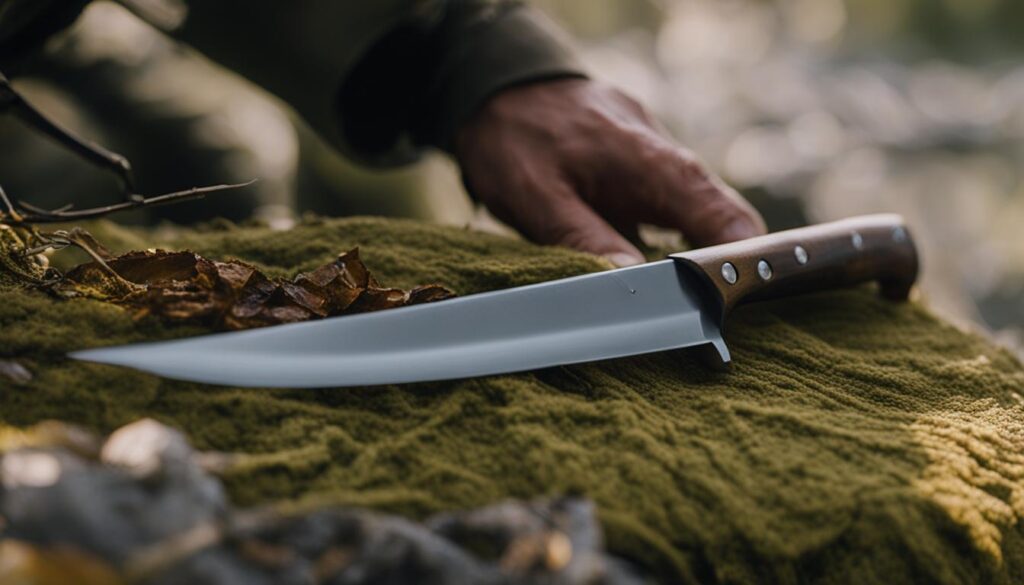
Table: Pros and Cons of Different Sharpening Methods
| Sharpening Method | Pros | Cons |
|---|---|---|
| Sharpening Stones |
|
|
| Electric Sharpeners |
|
|
| Sharpening Rods |
|
|
How To Sharpen A Hunting Knife Using A Whetstone
Sharpening a hunting knife using a whetstone is a traditional yet highly effective method. It requires precision and attention to detail to achieve a razor-sharp edge. Here, I will guide you through the step-by-step process of sharpening your hunting knife using a whetstone.
Materials you will need:
- A medium grit whetstone
- A clean, damp cloth
- A honing rod
- A lubricant (such as water or oil)
Follow these steps to sharpen your hunting knife:
- Prepare the whetstone: Soak the whetstone in water for about 10-15 minutes to ensure it is fully saturated. Alternatively, if you’re using an oil stone, apply a few drops of honing oil on the stone’s surface. Place the stone on a stable surface, making sure it won’t move during the sharpening process.
- Establish a consistent angle: Hold the knife securely with one hand, keeping the blade’s edge against the whetstone at a consistent angle. The optimal angle can vary depending on the type of knife you have, but a general guideline is to maintain a 20-degree angle.
- Sharpen one side of the blade: Starting from the base of the blade, apply moderate pressure and move the knife in a sweeping motion across the whetstone. Use the entire length of the whetstone to ensure even sharpening. Repeat this process several times, gradually increasing the pressure with each stroke. Remember to maintain a consistent angle throughout.
- Sharpen the other side: Flip the knife over and repeat the same sharpening process on the opposite side of the blade. This will ensure both sides of the blade are equally sharp.
- Remove burrs: After sharpening both sides of the blade, use a honing rod to remove any remaining burrs and polish the edge. Hold the honing rod vertically and, using light pressure, draw the knife’s edge down the rod in a sweeping motion, starting from the base of the blade and moving towards the tip. Repeat this process several times on both sides of the blade.
Once you are satisfied with the sharpness of your hunting knife, wipe the blade clean with a damp cloth to remove any metal particles or debris. Applying a light coating of oil will help protect the blade from moisture and corrosion.
Remember, sharpening a hunting knife using a whetstone requires practice and patience. With time, you will develop a feel for the correct angle and pressure needed to achieve a razor-sharp edge. Regular maintenance and sharpening will ensure your hunting knife remains in optimal condition, ready for your next outdoor adventure.
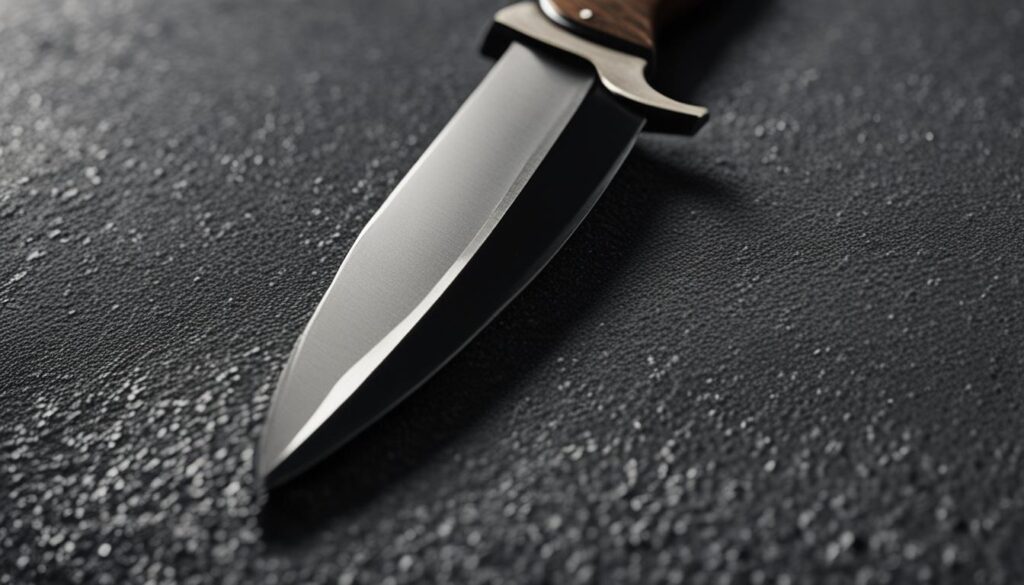

Conclusion
As a wet stone hunter, sharpening your hunting knife using a wet stone is a skill that can greatly enhance your hunting experience. By following the proper techniques and utilizing the right tools, you can keep your knife sharp and ready for any task in the field.
Remember, maintaining the optimal performance of your hunting knife starts with understanding the type of knife you have. Different blade designs require different sharpening techniques, so it’s important to choose the right method for your specific knife.
Cleaning and preparing your knife before sharpening, using a consistent angle while sharpening, and removing any burrs are essential steps to achieve a razor-sharp edge. With these practices, your hunting knife will perform efficiently and safely, enhancing your overall hunting success.
So, embrace the art of wet stone sharpening and elevate your hunting game. Keep your blade sharp, and enjoy the thrill of a well-honed knife on your next hunting adventure.
FAQ
What is the best type of sharpening tool for hunting knives?
The best type of sharpening tool for hunting knives depends on personal preference and skill level. Some popular options include sharpening stones, honing rods, electric sharpeners, pull-through sharpeners, and guided sharpening systems.
How often should I sharpen my hunting knife?
The frequency of sharpening your hunting knife will depend on how often you use it and the type of tasks you perform with it. As a general guideline, it is recommended to sharpen your knife after every few uses to maintain its optimal performance.
What angle should I sharpen my hunting knife at?
The correct sharpening angle for your hunting knife can vary depending on the type of blade. It is best to refer to the manufacturer’s recommendations or use a sharpening guide to determine the appropriate angle for your specific knife.
Can I use a wet stone to sharpen other types of knives?
Yes, a wet stone can be used to sharpen various types of knives, including kitchen knives, pocket knives, and utility knives. However, it is important to choose the appropriate sharpening technique and angle based on the specific blade design.
How do I maintain the sharpness of my hunting knife?
To maintain the sharpness of your hunting knife, it is important to store it properly, clean it regularly, and avoid using it on hard surfaces or cutting through bone. Additionally, using a honing rod regularly can help maintain a sharp edge between sharpenings.


